
Island War: Four Pacific Battles is a collection of four board wargames published in 1975 by Simulations Publications Inc. (SPI) that simulates various battles between American and Japanese forces during the Pacific Campaign of World War II.

Island War: Four Pacific Battles is a collection of four board wargames published in 1975 by Simulations Publications Inc. (SPI) that simulates various battles between American and Japanese forces during the Pacific Campaign of World War II.
Island War is a "quadrigame", four thematically-connected games that use the same basic rules. The four games in the box are: [1]
Each game has includes two to five scenarios. [2]
The game box includes: [3]
After the success of SPI's first quadrigame, Blue & Gray , in May 1975, the company quickly produced more quadrigames over the next six months, including Blue & Gray II, Napoleon at War, and Modern Battles. The last to appear in 1975 was Island War, which debuted strongly, moving to #2 in SPI's Top Ten Games list the month it was published. But that initial flush of success was temporary and Island War fell off the Top Ten list after six months. [4] In a 1976 poll conducted by SPI to determine the most popular wargames in North America, Island War was SPI's lowest-placed quadrigame in the poll, ranking only 93rd of 202 games. (In contrast, Blue & Gray and Napoleon at War tied for 23rd, and Modern Battles placed 33rd.) [5] : 151
Each of the games in Island War were offered for individual sale as well, but none sold well enough to crack SPI's Top Ten list. [4]
After the demise of SPI, Sunset Games (サンセットゲ) acquired the game license and published a Japanese language edition titled 孤島の戦場 (Battlefield on an Isolated Island). [6]
In Issue 12 of Fire & Movement , Friedrich Helfferich noted, "The Island War quad is based on a rather conventional system with fixed active zones of control and standard terrain effects." Helfferich concluded, "The game system is easy to learn and quite effective. The games themselves are of uneven quality." [7]
In the 1977 book The Comprehensive Guide to Board Wargaming , contributor Marcus Watney thought all the games were "notable for realistic artillery rules" but overall called this collection of games "a very mixed bag" [5] : 151 as he reviewed the individual games:
In his 1980 book The Best of Board Wargaming , Nicholas Palmer theorized that the low popularity of this quadrigame was "perhaps due to the rather one-sided nature of the fighting in the Pacific after Guadalcanal." Palmer had mixed emotions about the four games.
Bruce Quarrie, writing for Airfix Magazine, allowed that SPI's quadrigames use "a basic game system simple enough to cover centuries of warfare with only minor concessions to the arms and tactics of different ages." But Quarrie found Island War to be too simplistic, only giving the players "a vague impression of the nature of the forces in conflict and the difficulties or benefits of the terrain they fought over. It cannot in its present form, show the distinctions between infantry, artillery and cavalry or armour, nor their inter-relation on the battlefield." Quarrie suggest that "a few simple optional rules [...] would add a lot to the games both in terms of realism and enjoyment." Comparing the four games, Quarrie thought that "They are all much the same with slight differences to allow for particular aspects of the battles." [3]
In Issue 71 of Fire & Movement, Joe Miranda commented, "While not the final word on these battles, Island War was fairly simple and easy to play — as intended." [9]
In The Guide to Simulations/Games for Education and Training, Martin Campion noted that "Artillery functions in the game quite different from other units. It is particularly flexible and therefore important." He also liked the rule allowing for Japanese Banzai attacks, saying that it gave the game, "A significant flavor." [2]
In a retrospective review in Issue 20 of Simulacrum, Peter Bartlett noted "Small maps and low counter density make for a quick and easy setup, even in a limited space. These are games that can easily be set up, played, and put away in one evening after the dishes are done and the kids are put to bed. For those who are hard pressed to find a face-to-face opponent, as I am, these games are highly suited to solitaire play." Bartlett concluded, "Island War falls solidly on the game end of the game-simulation spectrum. But sometimes it’s okay for a game to just be a game. All four games are clean, simple games, and don’t need a lot of deep thought to enjoy." [10]
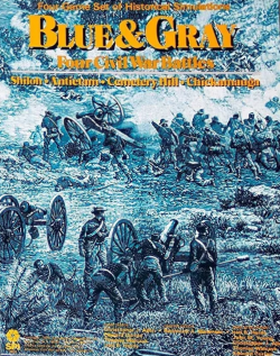
Blue & Gray: Four American Civil War Battles is a board wargame originally published by Simulations Publications, Inc. (SPI) in 1975 that simulates four battles from the American Civil War.

'CA': Tactical Naval Warfare in the Pacific, 1941–45 is a board wargame published by Simulations Publications Inc. (SPI) in 1973 that simulates surface naval battles during the Pacific Campaign of the Second World War.

Napoleon at War, subtitled "Four Battles", is a collection of four board wargames published by Simulations Publications Inc. (SPI) in 1975 that simulates various battles fought by Napoleon.

Bloody Ridge, subtitled "Turning Point on Guadalcanal, September 1942", is a board wargame published by Simulations Publications Inc. (SPI) in 1975 that simulates the Guadalcanal Campaign during World War II. The game was originally published as part of the Island War: Four Pacific Battles "quadrigame" — a gamebox containing four games simulating four separate battles that all use the same rules. Bloody Ridge was also published as an individual "folio game."
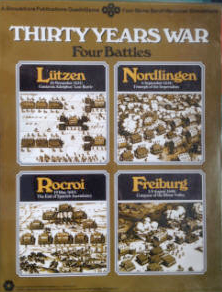
Thirty Years War, subtitled "Four Battles", is a "quadrigame" — four separate board wargames packaged in one box that use a common set of rules — published by Simulations Publications Inc. (SPI) in 1976. The four games simulate different battles during the Thirty Years' War, and were sold individually as well as in the quadrigame format. Some of the games were well received by critics, but overall, the quadrigame did not sell well.
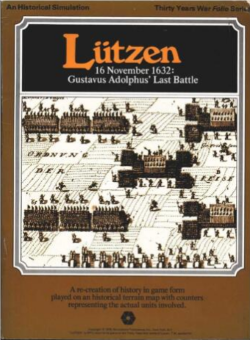
Lützen is a board wargame published by Simulations Publications Inc. (SPI) in 1976 that simulates the 1632 Battle of Lützen during the Thirty Years' War. Lützen was originally sold as one of four separate games packaged together in Thirty Years War, a "quadrigame". Many critics called it one of the better games of the four, and Lützen was also published as an individual game.

Rocroi, subtitled "19 May 1643 – The End of Spanish Ascendancy", is a board wargame published by Simulations Publications Inc. (SPI) in 1976 that simulates the 1643 Battle of Rocroi during the Thirty Years' War. Rocroi was originally sold as one of four separate games packaged together in Thirty Years War, a "quadrigame", but it was also published as an individual game. It received mixed reviews from critics, some of whom called it a "bland tactical problem", while others declared it was the best game of the four in the Thirty Years War box.

Freiburg, subtitled "3–9 August 1644 – Conquest of the Rhine Valley", is a board wargame published by Simulations Publications Inc. (SPI) in 1976 that simulates the 1644 Battle of Freiburg during the Thirty Years' War. Freiburg was originally sold as one of four separate games packaged together in Thirty Years War, a "quadrigame", but it was also published as an individual game. It received poor reviews from critics, who called it the weakest of the four games in the Thirty Years War box, "a series of slogging matches", "not much fun", and "relatively boring."

Westwall: Four Battles to Germany is a collection of four board wargames published by Simulations Publications (SPI) in 1976 that simulate battles in Europe in late 1944 and early 1945 during World War II.

Blue & Gray II, subtitled "Four American Civil War Battles", is a collection of four board wargames originally published by Simulations Publications, Inc. (SPI) in 1975 that each simulate a battle from the American Civil War. It is the sequel to Blue & Gray published earlier in the year. Each of the four games was also published as individual "folio games."

Hurtgen Forest, subtitled "Approach to the Roer, November 1944 ", is a board wargame published by Simulations Publications Inc. (SPI) in 1976 that simulates the Battle of Hürtgen Forest during the final year of World War II. The game was originally published by SPI as part of a four-game collection titled Westwall: Four Battles to Germany, but it was also released as an individual "folio game." While the quadrigame Westwall received good reviews from critics, the static nature of Hurtgen Forest was less well received.
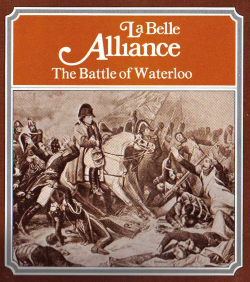
La Belle Alliance: The Battle of Waterloo is a board wargame published by Simulations Publications Inc. (SPI) in 1976 that simulates the Battle of Waterloo in 1815. It was one of four games that were published as part of the "quadrigame" titled Napoleon's Last Battles, but was also released as an individual "folio game", packaged in a shrinkwrapped cardboard folio.

The Battle of Nations, subtitled "The Encirclement at Leipzig, 16–19 October 1813", is a board wargame published by Simulations Publications Inc. (SPI) in 1975 that simulates the Battle of Leipzig in 1813. It was one of four games that were published as part of the "quadrigame" titled Napoleon at War, but was also released as a "folio game", packaged in a shrinkwrapped cardboard folio. It was popular in a 1976 poll of favorite wargames, and critics also gave it favorable reviews.

Jena-Auerstadt: The Battle for Prussia is a board wargame published by Simulations Publications Inc. (SPI) in 1975 that simulates the twin battles of Jena and Auerstadt in October 1806. It was one of four games that were part of the "quadrigame" titled Napoleon at War, but it was also released as an individual "folio game" packaged in a shrinkwrapped cardstock folio. Jena-Auerstadt was rated highly in a 1976 poll of favorite wargames, but critics questioned whether its simplicity was capable of simulating a complicated two-part battle.

Leyte: Return to the Philippines, October 1944 is a board wargame published in 1975 by Simulations Publications Inc. (SPI) that simulates the return of General Douglas MacArthur to the Philippines during World War II. The game was originally published as part of the four-game collection Island War: Four Pacific Battles, but was also released as an individual game. Leyte was not considered an outstanding success by critics.
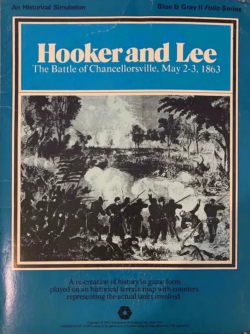
Hooker and Lee, subtitled "The Battle of Chancellorsville, May 2-3, 1863, Nov. 24-25, 1863" is a board wargame published by Simulations Publications, Inc. (SPI) in 1975 that simulates the Battle of Chancellorsville during the American Civil War. The game was originally part of the four-game collection Blue & Gray II, and was also released as a stand-alone "folio" game.

Saipan: Conquest of the Marianas, June 1944 is a board wargame published by Simulations Publications Inc. (SPI) in 1975 that simulates the Battle of Saipan during World War II. Saipan was originally published as one of four games in the popular collection Island War: Four Pacific Battles, but was also released as an individual game.

Okinawa: The Last Battle, April 1945 is a board wargame published by Simulations Publications Inc. (SPI) in 1975 that simulates the Battle of Okinawa during World War II. Okinawa was originally published as one of four games in the popular collection Island War: Four Pacific Battles, but was also released as an individual game.

Remagen: Bridgehead on the Rhine, March 1945 is a board wargame published by Simulations Publications Inc. (SPI) in 1976 that simulates the Battle of Remagen during World War II. The game was originally published as part of the Westwall: Four Battles to Germany "quadrigame" — a gamebox containing four games simulating four separate battles that all use the same rules. Remagen was also published as an individual "folio game."
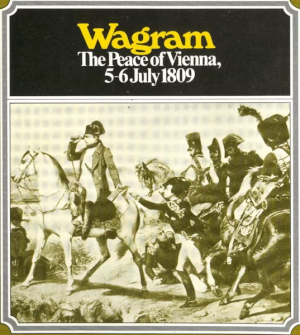
Wagram: The Peace of Vienna, 5–6 July 1809 is a board wargame published by Simulations Publications Inc. (SPI) in 1975 that simulates the Battle of Wagram in July 1809. It was one of four games that were part of the "quadrigame" titled Napoleon at War, but it was also released as an individual game with a set of metal miniatures. Wagram was rated highly in a 1976 poll of favorite wargames, and critics called it the best of the four games in the Napoleon at War box.